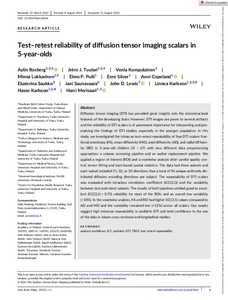Test-retest reliability of diffusion tensor imaging scalars in 5-year-olds
Rosberg Aylin; Tuulari Jetro J; Kumpulainen Venla; Lukkarinen Minna; Pulli Elmo P; Silver Eero; Copeland Anni; Saukko Ekaterina; Saunavaara Jani; Lewis John D; Karlsson Linnea; Karlsson Hasse; Merisaari Harri
Test-retest reliability of diffusion tensor imaging scalars in 5-year-olds
Rosberg Aylin
Tuulari Jetro J
Kumpulainen Venla
Lukkarinen Minna
Pulli Elmo P
Silver Eero
Copeland Anni
Saukko Ekaterina
Saunavaara Jani
Lewis John D
Karlsson Linnea
Karlsson Hasse
Merisaari Harri
WILEY
Julkaisun pysyvä osoite on:
https://urn.fi/URN:NBN:fi-fe2022102463054
https://urn.fi/URN:NBN:fi-fe2022102463054
Tiivistelmä
Diffusion tensor imaging (DTI) has provided great insights into the microstructural features of the developing brain. However, DTI images are prone to several artifacts and the reliability of DTI scalars is of paramount importance for interpreting and generalizing the findings of DTI studies, especially in the younger population. In this study, we investigated the intrascan test-retest repeatability of four DTI scalars: fractional anisotropy (FA), mean diffusivity (MD), axial diffusivity (AD), and radial diffusivity (RD) in 5-year-old children (N = 67) with two different data preprocessing approaches: a volume censoring pipeline and an outlier replacement pipeline. We applied a region of interest (ROI) and a voxelwise analysis after careful quality control, tensor fitting and tract-based spatial statistics. The data had three subsets and each subset included 31, 32, or 33 directions thus a total of 96 unique uniformly distributed diffusion encoding directions per subject. The repeatability of DTI scalars was evaluated with intraclass correlation coefficient (ICC(3,1)) and the variability between test and retest subsets. The results of both pipelines yielded good to excellent (ICC(3,1) > 0.75) reliability for most of the ROIs and an overall low variability (<10%). In the voxelwise analysis, FA and RD had higher ICC(3,1) values compared to AD and MD and the variability remained low (<12%) across all scalars. Our results suggest high intrascan repeatability in pediatric DTI and lend confidence to the use of the data in future cross-sectional and longitudinal studies.
Kokoelmat
- Rinnakkaistallenteet [27094]
